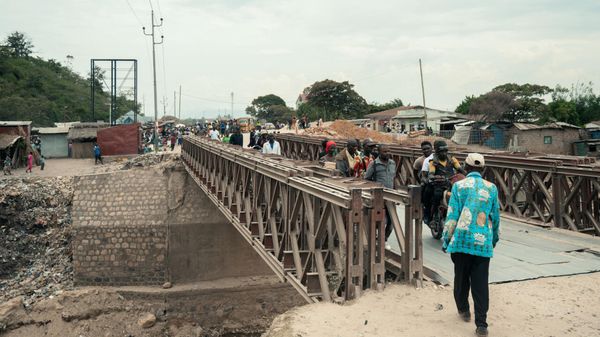
A firepit is an essential addition for an Autumnal evening gathering, so long as you're sure to avoid these rookie mistakes.
Even though the summer months may be coming to a close, it's by no means the end of outdoor hosting season. That's right, don't cover up your outdoor furniture just yet. Sure, the temperatures may be dropping a bit, but that makes it the perfect excuse to light up your firepit ideas. Cozy up around your garden's pièce de résistance and relish in the fact that you've managed to make your garden a season-round success.
But, this is not to say that the firepit is an entirely risk-free investment. While they may be safer than a homemade bonfire, an open flame is always going to require some extra precautions and care, and the potential for dangerous mistakes is higher than you may initially realise. Consider this your guide to safe firepit usage, so you can make the most of your fireside nights.
1. Picking the Wrong Fuel

With so many striking, stylish firepits on the market, it's easy to make your decision on a purely aesthetic basis. But before you buy, we encourage you to take the time to learn the differences between wood vs gas firepits, and make sure you're investing in the best one for your space.
Both approaches have their own merits, so your choice should come down to which fuel source is better suited to your setting. As Eric Tamminga, founder of Iron Embers, explains, "For an urban environment, a gas firepit is likely the better choice, to avoid disrupting neighbors with smoke, and to avoid any safety issues with buildings too close to the pit. In a more spacious environment, a traditional wood-burning firepit is often the better choice."
Opting for the wrong fuel type is not just inconvenient; it can, in some cases, be dangerous. In drought-prone areas, wood-burning firepits can increase the risk of wildfires, while gas-fuelled options are generally safer in dry conditions. Gas, however, can be surprisingly costly to run and install, especially if it requires a connection to the mains gas.
2. Poor Placement

Putting your firepit in the wrong spot won't just throw off your backyard feng shui; it can introduce higher risks of danger.
Much like the previous mistake, this issue can often come about from an aesthetic-led approach. "Many firepits are built in spots that look good on paper but don’t work in real life," comments landscape designer Trent Brown.
This can manifest in several ways: "Sometimes they’re tucked away in a far corner of the yard, which makes them pretty to look at from the house, but not practical to get to with food and drinks. Other times, they’re placed under garden canopies or too close to the house, which can be a serious fire hazard if you’re using a wood-burning pit," Trent continues.
While gas-burning models still carry a certain level of risk, these restrictions are particularly pertinent for traditional fire-fuelled pits. With gas, you can have a certain level of control over the flame, ensuring it never rises to the point of danger, a luxury you aren't granted when it comes to traditional firepits.
Trent recommends mapping out how the firepit will sit alongside the rest of your garden design. He says, "Consider the view both from the house and from the seating area around the fire. If it’s wood-burning, give 15-20' of clearance from trees and buildings. If it’s propane or natural gas, you have more flexibility, but access and sightlines still matter."
3. Cutting Costs

There's a time and a place for a budget option, but trust me, your firepit is not one of them. Of course, there's an obvious appeal to the cheaper models, but with something as potentially risky as an open fire, it's always best to err on the side of caution.
"Firepits are a product made for enjoying, for slowing down and enjoying the ambiance. One sure-fire way to ruin that enjoyment is to have a cheap product that falls apart, rusts through the bottom, and burns holes through the spark screen," argues Eric.
While most firepits are admittedly more costly purchases, this is because they should be seen as investments. A staple that will last you for several summers to come. Opting to purchase from a trusted place to buy firepits is the first step in achieving a beautiful and safe design.
Eric adds, "This is also a safety hazard, as coals can escape the firepit. The best way to fix this is to invest in a quality firepit."
4. Damaging Your Materials

Firepit mistakes aren't just limited to the firepit itself, but can actually involve the areas surrounding your pit as well. Namely, the quality of the hardscaping materials used in the nearby areas.
Not all materials are equally suitable for exposure to high temperatures. Although this may not be your top priority when initially designing your garden, when you later choose to bring in a firepit, it can result in significant issues.
This will be particularly significant when it comes to your garden flooring. Some materials, like wooden decking, are unable to withstand the high temperatures of a firepit, and you can end up with scorched floors. Instead, opt for fire-resistant materials, like fire brick or concrete.
5. Be Mindful of Sizing

Say you've spotted your perfect, dream firepit, the perfect focal point for your upcoming garden parties. But have you stopped to consider how it will fit in your space yet? It's all too easy to rush into a purchase and then end up regretting it.
Danielle Le Vaillant, from Cox & Cox, suggests, "Consider the size of your garden before you make a purchase. A massive brazier may work in a field, but will overpower a small garden and leave you with very little space to arrange seating safely around the firepit."
This is especially important if you're envisioning a firepit seating area. If you opt for a design that's too small, you may end up feeling cramped around the fire. However, go too large and you'll struggle to find garden furniture that will fit around it.
For a traditional wood-burning fire with a modern design, this is the perfect option. The design features a discrete wood storage space, so you won't have to clutter up the surrounding areas.
The square console firepit has a sleek, industrial feel, ideal for modern settings. It uses fire for fuel, offering that cozy crackling experience.
This petite concrete-look firepit can be fuelled using wood or charcoal, and comes with a removable steel grill, so you can seamlessly switch from cozy fireside hangouts to a BBQ session.
This smart smokeless firepit has a coffee table-like design, so you and your guests can easily gather around it and spend an evening basking in its warmth. But the glass shield and adjustable flame settings ensure optimal safety and protection.
Solo Stove is known for its signature smoke-free designs, perfect for those of us with smaller gardens. The Bonfire pit is the largest model by Solo Stoves, designed with enough space for 4-6 people to gather around, making it a perfect purchase for a family garden. It's constructed out of a highly durable type of stainless steel, which is virtually weatherproof, so you can comfortably leave it outside year-round without fear of rusting.
Just because you have a small garden doesn't mean you have to miss out on the fun of a firepit. This taller, narrower design offers all the drama and warmth of a traditional firepit, without the space-hogging design.
FAQs
Can You Burn Wood in a Garden?
The answer to this question is not as simple as you may expect. While generally, yes, you can burn wood in your garden, this is dependent on the type of wood you're planning on burning.
Clean, untreated natural hardwoods are permitted, but any type of treated wood must not be burnt in your garden, as they release toxic chemicals into the air. However, even untreated wood, while technically allowed, is not always advisable, especially if you live close to others, as the smoke can be bothersome.
Not into firepits? No worries, there are plenty of other outdoor heating options out there to keep you warmer through the chilly months.







